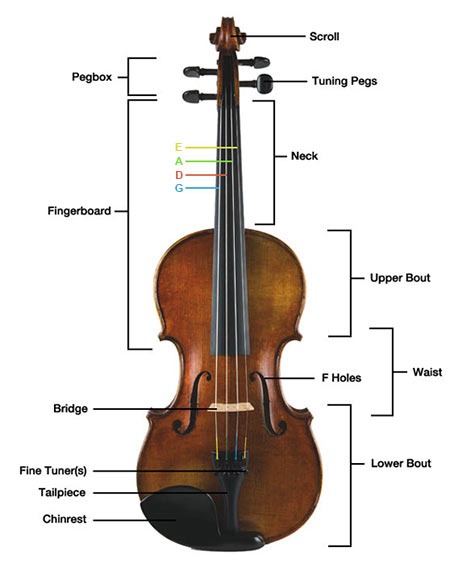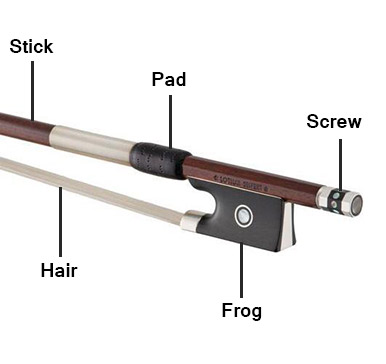Parts of the Violin
Knowing the names of the different parts of the violin is essential for any beginner, so that the player has a clear understanding of what parts they may need to interact with in order to retune, restring and look after their instrument.
Parts of the Violin

Scroll
The scroll of the violin is the very top of the instrument above the pegbox. The scroll can be identified by its characteristic curl design; however some older instruments have scrolls that were more elaborately carved with animals or figures.
Tuning Pegs/Pegbox
The tuning pegs and pegbox are located at the top of the instrument by the scroll. This is where the strings are attached at the top. The end of the string is inserted into a hole in the peg, which is then wound in order to tighten the string. The majority of tuning is performed by tightening the peg, with fine tuners being used for strings out by less than half a tone.
Nut
The nut is the connector between the peg box and the fingerboard. The nut has four grooves in it which the strings sit in so that they are properly spaced. If you restring a violin or the strings are very loose, then you should check that the strings are sitting in the grooves at the nut (and at the bridge) before you start to tighten the strings.
Strings
The strings on the violin are tuned G,D,A,E from lowest to highest. Strings differ significantly in quality, and the quality of the strings makes a considerable difference to the tonal quality produced by the instrument. Strings are made from a variety of different metals (mainly aluminium, steel and gold for the E-string). However, some synthetic materials are also used to produce strings and 'cat gut' strings made out of animal intestine are still relatively popular today.
Neck
The neck of the instrument is the part of the violin that carries most of the stress of the strings. It is the long wooden piece behind the fingerboard, which the fingerboard is glued to. The neck of modern violins is more slender and longer than the neck of the baroque violins.
Fingerboard
The fingerboard is the smooth black playing surface glued to the neck of the violin underneath the strings. Violinists sometimes get black residue on their fingers on the left-hand due to the black polish rubbing off. Eventually the fingerboard would need refinishing if this starts to happen.
Body
The body of the violin is the part that amplifies the sound in acoustic violins. The body of the violin can be made of a variety of different woods. While most violins have two-piece backs that are joined together with a seam down the middle, one-piece backs are preferred due to their increased resonance.
Sound Post
The sound post is the round post inside the violin that runs from the front-piece to the back-piece under the bridge of the violin. The sounding post plays a key role in how the violin produces sound, and it also helps to support the structure of the violin from the pressure created by the tension of the strings.
F Holes
After the vibration from the string reverberates within the body of the violin, the sound waves are directed out of the body through the F holes. A good tip for beginners is to direct the F holes towards your audience. Doing this will allow the audience to experience the best sound possible. Of course, you do not need to worry about this if you play an electric violin, or if you are playing with a pick-up.
Bridge
The bridge of the violin comes in varying angles of curvature. A smaller angle makes it easier to play double or triple stops (playing two or three strings at the same time.) Whereas more curved bridges make it easier to hit the right notes without scraping across a wrong string. Classical violinists tend to have more curved bridges. Fiddle or country players have flatter bridges. The bridge also has ridges on it that help to space the strings out evenly. On good-quality E-strings, a small plastic tube should be included wrapped around the string. This should be place over the bridge to prevent the thin E-string from cutting into the wood.
Fine Tuners
Fine tuners can be found either on all four strings, or just the E string. If you are a beginner, it is best to choose a violin with four fine tuners as it makes it significantly less likely that you will break a string while tuning. Fine tuners are essentially a screw that presses down a lever that then tightens the string fractionally. When a fine tuner reaches the end of the screw, it should be unscrewed completely and then the peg should be tightened before again using the fine tuner.
Tailpiece/Endpin
The tailpiece is what the strings are attached to at the bottom of the instrument, closest to the players chin. The tailpiece is attached to the bottom of the instrument by the endpin or end button, a small button on the side of the violin that rubs against the players neck.
Chin Rest
The chin rest is an additional invention that supports the players chin when they are playing the violin. The chin rest is important because it helps the player to hold the violin, which means that the left hand can then move freely up and down the fingerboard.
Parts of the Bow

Hair
The hair of the bow is the part that touches the string when playing. Usually the hair is made out of either a synthetic material or horse hair, and these strands need to be well-rosined to produce sound. If your bow is not well rosined, you may find that it slips on the string and produces a softer, whisper-like tone.
Frog
The frog is the part of the bow that the violinist holds. The frog is where all the mechanics of the bow happen.
Screw
The screw is on the end of the frog which tightens and loosens the hair. If the screw on the end of the frog is completely unscrewed then the frog comes off the bow (it is easy to reattach) when the screw is tightened it stretches the hair of the bow closer to the end of the bow, thus tightening the tension of the hairs.
Stick
The main stick of the bow is usually made of wood, sometimes with a metal core. The stick needs to be supple and bendy to be able to support the tightening and loosening of the bow hair. A good bow should be light, and have a balance point (the point where you can balance the bow on one finger) around a quarter of the way up the bow from the frog. The balance point is important as it allows the violinist to perform advanced technical movements like spiccato (where the bow bounces off the string between each note).
Pad
The pad of the bow assists the player in holding the bow.




